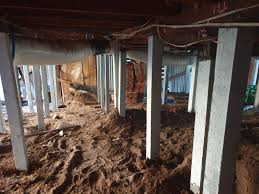The foundation rehabilitation process is designed to restore the strength and stability of structures that are compromised by problems with their foundation RECTIFY. Foundation problems, whether caused by poor building practices or the environment, can cause structural instability. Techniques for foundation rehabilitation address the underlying problems, stop further degradation, and guarantee long-term durability. Explore the significance of foundation rehabilitation, and key components that are involved.

Assessment of structural damage:
First, a foundation assessment is conducted to determine the damage extent and underlying cause. Engineers and technicians use advanced technologies such as laser levels and ground penetrating radar to identify foundation problems and create customized rehabilitation plans.
Understand the causes of foundation problems:
A variety of causes can lead to foundation problems, such as soil movement, infiltration by water, earthquake activity and poor construction techniques. In many areas, foundation problems are caused by expansive soils that shrink and expand with moisture changes. It is important to understand the causes of foundation issues in order to implement effective solutions.
Implementing Rehabilitation Techniques:
The type and extent of damage as well as soil and foundation conditions will determine the rehabilitation technique. Underpinning, soil stabilization and crack repair are all common rehabilitation techniques. The techniques are designed to strengthen the foundation and address any structural weakness. They also aim at preventing further settlement or movement.
Prioritizing structural safety and stability:
Foundation rehabilitation’s primary objective is to improve the stability and structural safety of infrastructure and buildings. Early and proactive rehabilitation can help reduce the risks of structural failure and protect the occupants, assets and value of property. Structural safety must be prioritized to maintain the functionality and integrity of buildings over time.
Long-Term Durability:
Investments in foundation rehabilitation offer long-term advantages for property owners. These include improved structural integrity and longevity of infrastructure and buildings, as well as reduced maintenance costs. Correctly repaired foundations can withstand the effects of environmental stress, resist soil movements, and stay stable for many years. Prioritizing the rehabilitation of properties can help property owners ensure durability and longevity.
Quality and Professional Experience:
Professional expertise, special equipment and compliance with industry standards are required for foundation rehabilitation. Engineers and contractors oversee the process to ensure that it is done safely and efficiently and according to regulatory requirements. Regular inspections and tests, as well as quality assurance measures such a regular testing and inspections, are used to verify and ensure the structural integrity of the building.
Foundation rehabilitation is an important component in maintaining safety, stability and long-term durability of infrastructure and buildings. Assessing structural damage, understanding the underlying causes and using rehabilitation techniques to prioritize safety and stability while ensuring durability over time, allows property owners to effectively repair and strengthen foundations. This will protect their investment and ensure resilience for future generations.